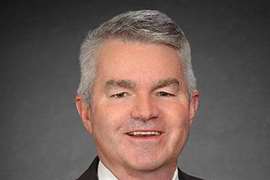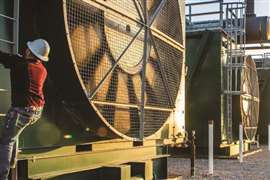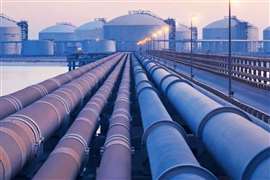Read this article in Français Deutsch Italiano Português Español
Cornerstones: Evolution of pipelines, compressor stations
November 19, 2025
The Cornerstones of Compression series has highlighted many significant products over more than 160 years of continuous progress. This is the fifth of seven Cornerstones of Compression corollary articles that provide a look the evolution of natural gas pipelines and compressor stations.
The Ohio Fuel Gas Company
The Ohio Fuel Gas Company was organized in 1902 as the Ohio Fuel Supply Company, following gas well drilling in central Ohio before the turn of the century. The last edition reviewed a number entries listed in a c.1923 journal, neatly hand-printed in blue ink, which documented the equipment and brief histories of most of the Ohio Fuel Gas pipeline compressor stations. The equipment at the stations ranged 50 hp (37 kW) to 1350 hp (1007 kW), with the largest station having units totaling 14,580 hp (10,872 kW). Several more stations are reviewed in this issue.
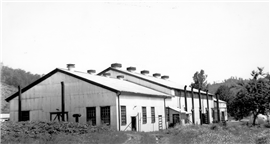 Hope Natural Gas Hubbell Station compressor building, 1939.
Hope Natural Gas Hubbell Station compressor building, 1939.
Miley Compressor Station was built in 1920 in Holmes County, Ohio. It was equipped with two 485 hp (362 kW) Cooper horizontals. Shreve Compressor Station was constructed in 1920 in Wayne County, Ohio. It was equipped with two 150 hp (112 kW) Cooper horizontals. Brill Compressor Station was constructed in 1921 in Washington County, Ohio. It was equipped with four 80 hp (60 kW) Clark Brothers horizontals. York Compressor Station was constructed in 1922 in Medina County, Ohio. The compression equipment included three 485 hp (362 kW) Cooper horizontals transferred from the Perrysville Station and two new identical Cooper horizontals. Brown Compressor Station was built in 1922 in Knox County, Ohio near the village of Jelloway. It was equipped with six 160 hp (119 kW) Cooper horizontals and one 80 hp (60 kW) Cooper horizontal. Perrysville Compressor Station was built in 1922 near Perrysville, Ohio. It was equipped with four 65 hp (48 kW) Miller horizontals. Hagan Compressor Station was built in 1923 in Noble County, Ohio. It was equipped with three 65 hp (48 kW) and four 110 hp (82 kW) Watts-Miller horizontals. Heslop Compressor Station was built in 1923 in Washington County, Ohio. It was equipped with three 65 hp (49 kW) Watts-Miller horizontals. Gay Compressor Station was also built in 1923 at Stewart in Athens County, Ohio. It was equipped with three 190 hp (142 kW) Watts-Miller horizontals.
Interestingly, as the large gas fields played out, smaller ones took their place, and the engine-compressors were smaller than the huge units that were installed in the early years. Most of the large steam and gas engine-compressor manufacturers of the time originated in Ohio and Western Pennsylvania. Ohio alone included Cooper and Reeves in Mount Vernon, Miller (and Watts-Miller) in Springfield, Laidlaw-Dunn-Gordon in Cincinnati and Rathburn-Jones in Toledo. The cost and effort involved in transporting and installing the large horizontal units favored purchasing from manufacturers that were close to the fields, and it can be seen that Ohio manufacturers Cooper and Miller dominated the Ohio Fuel Gas fleet after about 1916.
A look inside the Hubbell Station
A number of c.1939 photographs from Hope Natural Gas Company’s Hubbell compressor station, a pre-World War I era installation in West Virginia, provide further evidence of the self-sufficient infrastructure and village that had to be built at each remote station. Fig. 1 shows the Hubbell compressor building in 1939. The multiple engine exhaust stacks without mufflers must have provided quite a noisy “concert” in the nearby hills.
Fig. 2 is a view inside the engine-compressor building showing three of four large Westinghouse horizontal gas engine-compressors with two more Cooper horizontal units visible in the background.
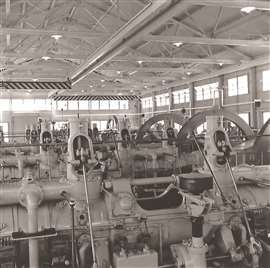 Inside view of the Hope Natural Gas Hubbell Station compressor building with four Westinghouse and two Cooper horizontal engine compressors visible, 1939.
Inside view of the Hope Natural Gas Hubbell Station compressor building with four Westinghouse and two Cooper horizontal engine compressors visible, 1939.
The compressor cylinders on the big Westinghouse units are shown in Fig. 3. As was common on slow-speed compressors well into the 1950s, the gas piping was directly connected to the large, long stroke cylinders without volume bottles to reduce pulsation. Acoustic design analysis and attenuation principles were not developed until much later when higher compressor speeds and pulsation frequencies led to more piping vibration problems and failures.
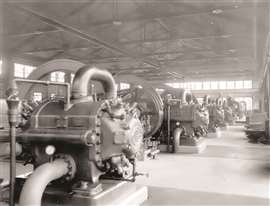 Compressor cylinders on the ends of the big Westinghouse units shown in Fig. 2, 1939.
Compressor cylinders on the ends of the big Westinghouse units shown in Fig. 2, 1939.
As was generally the case in all remote stations, all the electricity and the compressed air for the Hubbell facility was generated on site. A three-cylinder Westinghouse vertical gas engine drove a DC generator and a clutch-driven horizontal air compressor on the same drive-line to provide these utilities for the Hubbell station. Most compressor stations also had well-equipped machine shops for use in repairing machinery and equipment in the remote facility.
Fig. 4 shows several of the dozen or so company-owned dwellings that housed employees and their families on the Hubbell grounds. The grounds also had a large club house for social gatherings and with sleeping rooms for visitors to the site.
 Several of the dozen or so company-owned dwellings at the Hubbell Station, 1939.
Several of the dozen or so company-owned dwellings at the Hubbell Station, 1939.
MAGAZINE
NEWSLETTER

CONNECT WITH THE TEAM






